| |
 |
July 2015 |
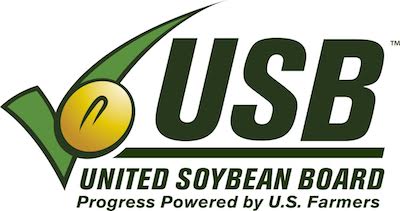 |
|
| |
| |
|
Welcome
Welcome to the July issue of the USAPEEC ASEAN Regional Office.
The newsletter seeks to provide readers with useful product and major market information for institutional and consumer users of U.S. poultry. Readers will find in every issue a variety of general market information, program activities as well as useful product information.
This month, we take a look at several market perspectives in the individual ASEAN countries.
Contents:
- U.S. Food Showcases in Hanoi and Danang
- Poultry and Meat Seminars sparked keen interest among the food service industry
- Singapore companies flock to Myanmar
- The Mediterranean Goodness
- Can Convenience Foods be healthy
|
|
|
| |
|
|
|
| |
|
Additional Market Information Available
We have updated our website to include more information on market reports and export documentation guidelines.
You can visit our ASEAN website at: www.usapeecasean.com |
|
|
| |
|
|
|
|
|
Buyer's Guide
USAPEEC has produced an online buyer’s guides for chicken, turkey, and duck products. These colorful guides give buyers the opportunity to see photographs and descriptions of the most commonly marketed products. The guides also provide information on proper handling of raw products, as well as nutritional information and an overview of how the U.S. Department of Agriculture's inspection and grading system for poultry ensures a wholesome product.
www.usapeec.org/importers/buyersguide.cfm |
|
| |
|
|
|
 |
|
U.S. Food Showcases in Hanoi and in Danang attract attendance of key food trade contacts
A wide range of interesting and new U.S. food products were displayed at the U.S. Food Showcase that took place in Hanoi and Danang, during 8 - 9 June, 2015 and 11 - 12 June, 2015 respectively. Key contacts in the food import trade and in the food service industry attended the two showcases.
Products represented at the U.S. Food Showcase included U.S. poultry, U.S. beef, frozen fries, cheese, apples, cherries, pistachios, peas, lentils, beans, processed wheat flour products, ginseng, popcorn and sauces, syrup, wines and juices.
Over 570 trade visitors who attended the showcases were treated to a sampling of unique and appetizing dishes prepared with the ingredients from the products that were on display. Several of the prepared dishes for display and taste testing included roast turkey and poultry ingredients combined with other products featuring different cuisines from a number of countries.
Mr. Mark Dries, the U.S. Agricultural Counselor, launched the start of the showcase with a welcome address. Exhibitors included nine co-operator boards and 13 private companies representing a variety of U.S. food brands. The co-operator boards that participated included USA Poultry & Egg Export Council, U.S. Meat & Export Federation, Raisin Administrative Committee, U.S. Potato Board, Washing Apple Commission, California Milk Advisory Board, Northwest Cherries, U.S. Dry Bean Board and U.S. Dry Pea & Lentil Council.
After the conclusion of the showcase in Hanoi on 9 June, exhibitors travelled to Danang to set up the U.S. Food Showcase. The same nine co-operators and 11 private companies participated in the showcase.
In conjunction with the U.S. Food Showcases in Hanoi and Danang, seminars on product and handling were held for local importers and the food service industry.
|
|
U.S. Food Showcase in Hanoi |
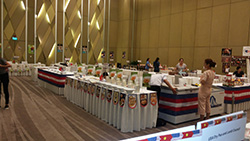 |
U.S. Food Showcase in Danang |
| |
|
|
|
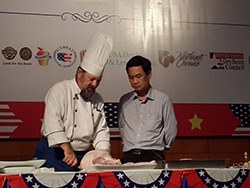 |
|
Poultry and Meat Seminars sparked keen interest among the food service industry
Six product and education seminars were held during the two-day food showcases in both Hanoi and Danang. The seminars included U.S. meat cutting and handling, cooking and baking with raisins, selection of potatoes and cooking with U.S. pulses. Poultry nutrition and poultry handling as well as cooking demonstrations incorporating food service ideas were also covered.
The product seminars attracted keen interest among the food & beverage managers, restaurateurs, chefs, retailers and food importers. The seminars increased greater awareness among the Vietnamese food trade of U.S. products, the correct handling, storage and the various uses in Asian and Western dishes.
Several co-operators, including the Raisin Administrative Committee, U.S. Meat Export Federation, U.S. Potato Board and U.S. Dry Pea & Lentil Council, presented the product seminars for the local food trade. Highlights of the seminar series included the introduction of poultry nutrition and education by Margaret Say, the regional director of USA Poultry & Egg Export Council.
Local celebrity Chef Norbert Ehrbar presented topics covering poultry handling and cutting of poultry, use of poultry in different recipes, food service ideas as well as cooking demonstrations.
The two sets of seminars in Hanoi and Danang attracted a total of over 180 participants from the food service industry. Many participants expressed keen interest in U.S. products as well as trying out the various recipe suggestions featured in both food showcases and seminars. |
|
Chef Norbert Presenting Poultry cutting and handling seminar |
| |
|
|
|
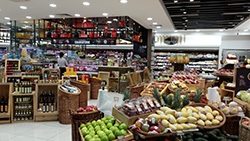 |
|
Singapore companies flock to Myanmar
Singapore companies are rushing in droves to set up businesses in Myanmar. Following the opening of the Myanmar market through the implementation of significant reforms to spur foreign investments in 2011, there have been a rapid influx of international investments including those from Singapore. The total cumulative foreign investments in Myanmar were recorded at US$45.3 billion as at Jan 1 2014. At the end of 2013, Singapore was the fourth largest foreign investor in Myanmar with a total cumulative direct investment of US$3.8 billion.
Singapore is also Myanmar’s third largest trading partner. Bi-lateral trade increased 6.6 per cent year on year to record S$3.23 billion (US$2.55 billion) in 2014. With a number of sectors opening their doors to foreign investments, Singapore companies have discovered various market opportunities in a wide number of economic sectors in the economy.
The growing ranks of the middle class, the increasing numbers of tourist arrivals and the fast expanding numbers of entrepreneurs and expatriate workers in Myanmar, have led to a robust rise in demand for a wide variety of consumer products and services.
Singapore companies planning to establish a business presence in Myanmar tend to narrow their focus to real estate development, infrastructure, logistics and the food service industry. Singapore companies also prefer to focus on consumer-oriented durables, beauty products, health care products, education services, restaurants and a wide spectrum of services industry. Several of the well-known Singapore companies like Les Amis, Quaich Bar and Modern Montessori have established outlets or branches in Yangon.
Two of Singapore’s largest banks, OCBC and United Overseas Bank have opened bank branches in Yangon. Other Singapore companies like Soilbuild,Tong Aik and Surbana International Consultants have been involved in real estate development, construction or project management in the country. |
|
Leading supermarket in Yangon |
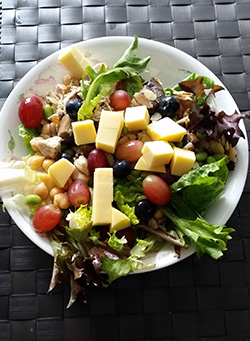 |
|
The Mediterranean Goodness
A healthy diet can help one maintain an optimal weight and avoid possible health problems. Contrary to popular opinion, a healthy diet is not about strict dietary restrictions or limiting the amount of food that you love.
Let us introduce you to a healthy diet that you can try out - The Mediterranean Diet.
The Mediterranean diet features healthy food and ingredients traditionally enjoyed by people in countries around the Mediterranean Sea including Greece, Spain, Morocco, Turkey and Tunisia. The diet is high in fruits, vegetables, whole grains, legumes, potatoes, nuts and seeds. The diet also features hefty amounts of olive oil and red wine, along with moderate amounts of fish, poultry, eggs, and dairy. Red meat is rarely eaten. Daily exercise is also a vital element of the diet. Other lifestyle practices synonymous with the diet include sharing meals with others and fostering a deep appreciation for the pleasures of eating healthy but delicious foods.
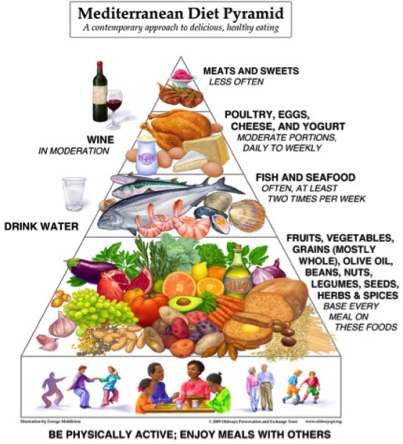
Credit: Oldways Preservation and Exchange
The Mediterranean pyramid is a notable guide recognized for promoting lifelong good health. It is widely used by consumers, educators and health professionals to implement healthier eating habits1. The pyramid was based on the dietary traditions of Crete, Greece and southern Italy during the 1960s. During this period, chronic disease rates in these countries were among the lowest when compared to other countries and adult life expectancy was among the highest despite limited medical services.
The Mediterranean diet has only recently gained popularity outside of its home, after it became recognised as a good way to improve health and prevent disease. Studies found that people who follow traditional Mediterranean lifestyle practices are healthier, leaner and live longer than people who follow typical Western dietary and lifestyle practices.
The Lyon Diet Heart Study was conducted to investigate the effects that the Mediterranean diet had on cardiovascular diseases. The researchers randomly divided 605 male and female heart attack survivors into two groups. One group was advised to eat the standard low-fat diet suggested for heart patients. The other group was advised to follow the Mediterranean dietary guidelines. The findings revealed that the people who followed the Mediterranean diet had a 70 percent lower death rate compared to those following the low-fat diet. The researchers also found that cancer rates among the Mediterranean group were 61 percent lower than those of the other group.
The Mediterranean diet emphasises foods that are low in fat and cholesterol but high in fibre. Reducing total fat is one of the easiest ways to trim calories, because fat has more than twice the calories as compared to carbohydrates or protein. Additionally, meals rich in lean protein and fibre are more filling and satisfying. Most foods included in the Mediterranean diet are fresh rather than highly processed. Cooking methods tend to be simple; foods are rarely deep-fried. The wide variety of foods makes it easy to stay with the Mediterranean diet for the long run. However, it is important to watch the portions of food consumed. Consuming an excess of high-calorie food such as nuts and olive oil can be detrimental to the diet.
Give the Mediterranean diet a shot if you are looking for a healthy diet. Over time, you will find that the Mediterranean diet could become a natural part of your life. Now,
Who says you cannot have delicious and healthy food while on a diet?
1Source: Oldways Preservation Trust |
|
Mediterranean Salad |
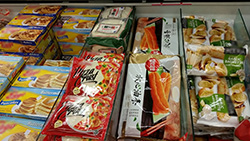 |
|
Can convenience foods be healthy?
Frozen pizzas and chicken pies, heat and serve meals, cut and diced apple, pre-packed salads – these are a few examples of convenience foods. With more people facing busy and hectic lifestyles, time-pressed customers are turning to convenience foods to settle their daily meals. Convenience food is defined as food that has been pre-prepared commercially and requires minimal further preparation by the consumer1.
Some convenience foods are less healthy as they are likely to contain food preservatives, food additives and have possibly higher fat, sugar and salt content. Eating too much of salt, sugar and fat may lead to health problems such as diabetes, and heart diseases2. Some examples of ‘less healthy’ convenience foods include instant noodles, TV dinners, chips, and chocolate bars.
There are many disadvantages when it comes to consuming convenience foods. The consumer would not be able to control the level of ingredients in the product (such as frozen pizza), and in turn, would not be able to control their intake of sugar, fat and salt. Convenience foods are usually higher in sodium content as it is one of the lower priced flavouring ingredients.
Our busy lifestyles are often at odds with the healthy aspirations of consumers who desire to save time, and yet strive to benefit from good nutrition. Even though there are disadvantages of consuming convenience food, convenience food does offer benefits to the present-day customer.
Modern production and preservation methods minimize nutritional loss of prepared and precooked products. Pre-cut, prewashed, frozen, canned fruits and vegetables and frozen vegetables save considerable time and convenience to the busy working households. Other examples of healthy convenience foods are oatmeal, salads, fresh fruit and nuts.
Pre-packed salads are an example of a convenience food that is fast gaining popularity in Singapore. This can be seen by the rise of salad shops island-wide. Apart from brick-and-mortar salad bars such as Salad Stop!, Toss & Turn, Grand Salads and Fresh+, there are also online salad stores such as Spinacas and Dressing Room Salad Bar. These online shops welcome self-collection and they offer delivery for a fee.
Salads are also popular in other countries such as the Philippines. Salad Stop! expanded their business into Philippines in December 2014. They have recently opened a second store in the Philippines.
To welcome the popularity of salads, Wendy’s Philippines reintroduced its well-loved all-you-can-eat salad bar concept, which was discontinued in the late nineties. At an affordable price of PHP199 (USD$4.50), customers can make their very own salad masterpiece from a bounty of fresh ingredients such as lettuce greens, cucumber slices, and grated cheese.
In summary, convenience foods allows one to spend less time planning meals and grocery shopping, lesser preparation time, fewer leftovers (with single-portion foods), and easier clean-up. Convenience foods can also provide options for those who do not like to cook, have limited skills or ability, or have poor or no kitchen facilities.
1 Source: Oxford Dictionaries
2 Source: Harvard Health Publication
|
|
Convenience food in a supermarket |
|
Disclaimer: All opinions and views expressed in the articles published in the newsletter are those of the individual journalists and do not necessarily reflect those of the publisher, the newsletter's sponsors or USA Poultry & Egg Export Council.
You have received this email because you have registered to get newsletters from USAPEEC ASEAN.
If you prefer not to receive these updates, please
click here
to unsubscribe.
Do not reply to this email. For enquiries, go to www.usapeecasean.com
® USA POULTRY & EGG EXPORT COUNCIL
541 Orchard Road, #15-04, Liat Towers, Singapore 238881 Tel: (65) 67371726 Fax: (65) 67371727
*|REWARDS|* |
|
|
|